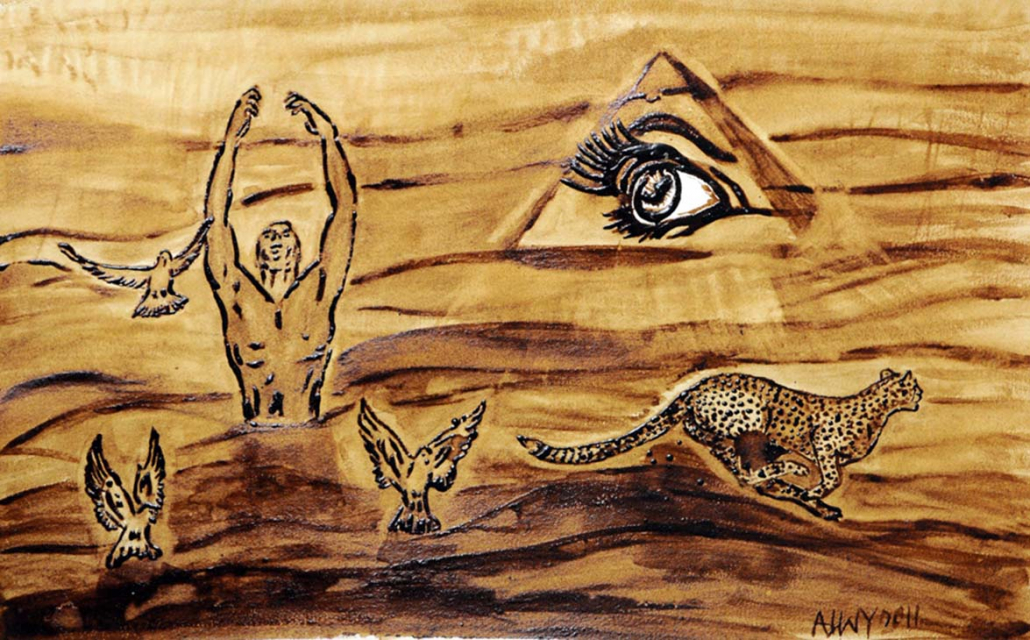Alwy Fadhel, ‘Fantasy’, coffee on paper (Refugee Art Project).
Visio Divina – ‘Dreaming free’
Alwy Fadhel was an asylum seeker detained for five years in the Villawood Detention Centre. His art consists of paintings made with instant coffee powder diluted in water. He was taught by an Iraqi detainee who had some knowledge of coffee art.
The use of food as an artistic medium says a lot about the resources provided to human beings in these detention centres.
His works focus on some themes, mainly hardships that detainees commonly face. These include homesickness, anxiety, depression, and the trauma of witnessing others commit acts of self-harm and suicide.
Focus reading
Luke 19:28-40.
In our gospel, Jesus borrows a donkey to make an entrance into Jerusalem for the Passover. The colt, we read, had never been ridden. We imagined the sensitivity Jesus showed to this young animal.
Various responses
Fadhel’s artwork evoked various responses. Some of us saw the ground as water/sea, others saw desert sand, perhaps quicksand – or even shifting ground, as in a dream, the scene shifting from perilous journey by sea or land. The figures – torso of a man with head and arms raised, three doves, pyramid with open eye, running cheetah or leopard – seemed like figures from a dream.
Symbols
We considered the symbolic meaning of the ground and figures.
The eye might be regarded the eye of God (wisdom or providence), or a symbol of surveillance.
The doves – taking flight or alighting – may represent freedom, peace, transcendence. We noted that the wing of the dove touches the right arm of the man – conferring the power of flight?
The cheetah runs at top speed to the right of the frame – representing strength, agility, escape. Is it running away from danger or toward prey?
The man reaches up, striking a balletic pose, graceful, as though rising from the waves or grave, breaking free.
Overall
The meaning of the work may be determined by the order of symbols observed – the guiding theme may be strength, freedom, vigilance, flight to safety. Each figure appears to be looking or pointing beyond the border of the image.
We were led to share the following prayers
“There is hope.”
“There is joy in running.”
“In the middle of your failures and disasters, you are still beautiful” (Lidia Yuknavitch).
“There can be peace amid chaos.”
“Prayers for all fleeing danger, for all seeking asylum, for refugees experiencing post-traumatic stress.”
“God, watch over us and guide us to safety.”
Next meditation will be May 8, 12pm. All welcome in the church and online:
Meeting ID: 828 4637 5215
Password: 895602.
The following guidelines (from https://www.prayerandpossibilities.com/pray-with-eyes-of-the-heart-visio-divina/) can be adapted for different occasions.
Find an image for prayer
You can use any type of image for Visio Divina. You might use images found in your church – a religious painting, a stained-glass window, or an icon.
Prepare your heart for prayer
Before you begin, choose your image and have it visible – either be near it in person or have the image pulled up on your phone or computer.
You may want to begin your time in prayer with a scripture reading. If you’re using a religious image, use the scripture related to that image. Or, use a Scripture from the day’s lectionary reading or just a favourite you want to pray.
Allow the image to speak to your heart
Open your eyes and look at the image you’ve selected. Let your eyes pause and focus on the part of the image they’re first drawn to.
Gaze upon just that part of the image for a minute or two. Then close your eyes, still seeing that part of the image in your mind.
Reflect on the entire image
Open your eyes and now look upon the whole image. Gaze upon all of the image, allowing it to draw forth a word, an emotion, or an image in your heart.
What do you hear God whispering into your heart? What thoughts or questions are raised? What emotions do you feel?
Continue to gaze and reflect as long as you need to, then briefly close and rest your eyes.
Pray through the image
Open your eyes. While looking upon the image, respond to God. Pray through the words, images, emotions, questions and thoughts that are now on your heart.
Continue to look upon the image as you pray. Then, close and rest your eyes briefly.
Rest and reflect in God
As you close out your time in prayer, open your eyes and gaze again upon the image. Rest in God’s presence as you reflect upon this prayer experience.
Consider how you’ll take this into your life. You may choose to journal about your experience.



